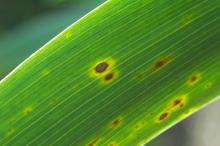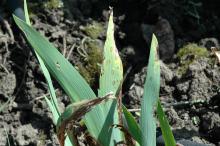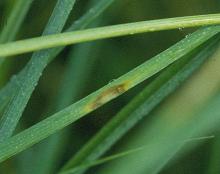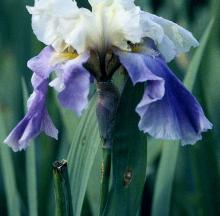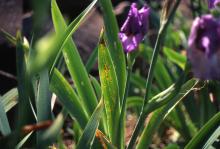Cause Mycosphaerella macrospora (asexual: Heterosporium gracile), a fungus formerly known as Didymellina macrospora. This is considered the most important foliar disease of iris and can significantly reduce bulb yields. It overwinters on dead leaves and other plant remains. Spores are produced in spring, dispersed by wind and rain and infect leaves directly or through stomata. Several disease cycles can occur in warm, wet weather. Acidic soils may accentuate the disease. Beardless cultivars show more resistance than bearded types.
Symptoms At first, tiny brown spots develop with a water-soaked edge, which later turns yellow. Toward the end of the season, after bloom, spots may become very numerous and run together. When infection is severe, affected leaves may die (even if leaves have only a few spots). Older spots are oval and have grayish centers with red-brown borders.
Cultural control
- Remove and destroy dead and infected leaves in fall.
- Maintain proper plant spacing to provide good air circulation.
- Rotate plantings.
- Maintain soil pH above 6, which could mean the addition of lime for acidic soils.
- Divide plants frequently enough to avoid serious congestion.
Chemical control Begin applying before disease appears (generally, when plants are 6 to 8 inches high) and repeated every 10 to 14 days while conditions favor disease development. Tank-mix and/or alternate products from different groups with different modes of action to prevent the buildup of resistant fungi. Limit the use of any one group during crop production.
- Armada 50 WDG at 3 to 9 oz/100 gal water. Do not use a silicone-based surfactant. Not for nursery or greenhouse use. Group 3 + 11 fungicide. 12-hr reentry.
- Bonide Fung-onil Multi-purpose Fungicide at 2.25 teaspoons/gal water. H
- Daconil Weather Stik at 1.38 pints/100 gal water (does not work well at this lower rate). Group M5 fungicide. 12-hr reentry.
- Eagle 20 EW at 12 fl oz/100 gal water. Group 3 fungicide. 24-hr reentry.
- Heritage at 2 to 4 oz/100 gal water plus a non-silicone-based wetter sticker. Group 11 fungicide. 4-hr reentry.
- Insignia SC at 3 to 6 fl oz/100 gal water. Do not use with organosilicate-based adjuvants. Group 11 fungicide. 12-hr reentry.
- Mancozeb-based products. Group M3 fungicides. 24-hr reentry.
- Fore 80 WP at 1.5 lb/100 gal water plus a spreader-sticker.
- Protect DF at 1 to 2 lb/100 gal water plus 2 to 4 oz spreader-sticker.
- Mural at 4 to 7 oz/100 gal water. Group 7 + 11 fungicide. 12-hr reentry.
- Myclobutanil 20 EW T&O at 6 to 12 fl oz/100 gal water plus spreading agent. May observe a PGR effect. Group 3 fungicide. 24-hr reentry.
- Ortho MAX Garden Disease Control at 2 teaspoons/gal water. H
- Pageant at 8 to 12 oz/100 gal water. Do not use with organosilicone-based adjuvants. Group 7 + 11 fungicide. 12-hr reentry.
- Spectracide Immunox Multi-Purpose Fungicide Spray Concentrate for Gardens at 2 fl oz/gal water. Group 3 fungicide. H
- Spectro 90 WDG at 1 to 2 lb/100 gal water. Group 1 + M5 fungicide. 12-hr reentry.
- Thiophanate-methyl-based products did not result in good control in several trials at Puyallup, WA. Group 1 fungicide. 12-hr reentry.
- Cleary's 3336 EG at 12 to 16 oz/100 gal water.
- OHP 6672 4.5 F at 10 to14.5 fl oz/100 gal water.
- Systec 1998 at 20 fl oz/100 gal water. Washington Only.
Reference Chastagner, G.A. and Kaufmann, P. 2005. Efficacy of fungicides in controlling leaf spot on bulbous iris. Acta Hort. 673:509-512.


